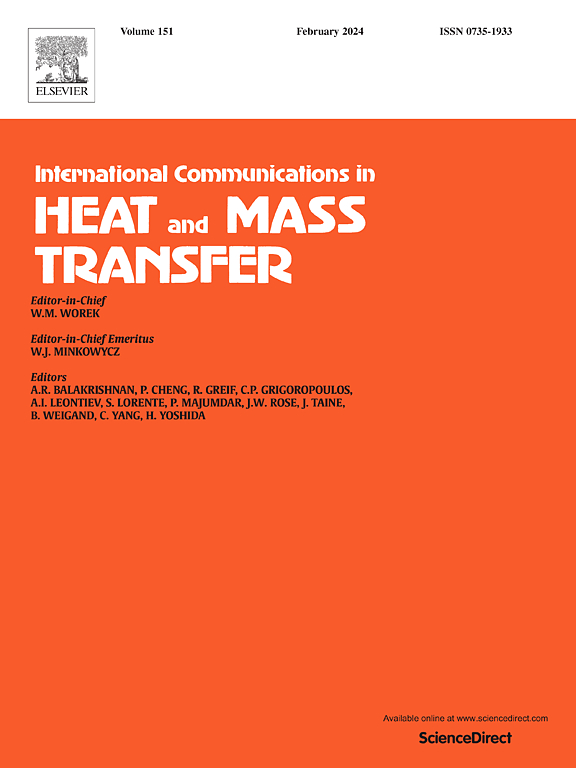Vortex-driven heat transfer enhancement in supercritical CO2: Structural optimization with claw-shaped lattice design for enhanced thermal performance
IF 6.4
2区 工程技术
Q1 MECHANICS
International Communications in Heat and Mass Transfer
Pub Date : 2025-06-28
DOI:10.1016/j.icheatmasstransfer.2025.109275
引用次数: 0
Abstract
This study conducted computational simulations to comparatively investigate the effects of various typical claw-shaped lattice structure arrays (LSAs) on the flow and heat transfer performance of supercritical CO2 in a vertically upward heated tube. The results indicate that the LSAs could effectively mitigate heat transfer deterioration (HTD) of supercritical CO2, by regulating the coupling mechanism between buoyancy and flow acceleration effects, reducing wall temperature, and enhancing heat transfer coefficient. Furthermore, the influence of buoyancy and flow acceleration on heat transfer characteristics are systematically analyzed, revealing the advantages of claw-shaped lattice structures in suppressing HTD. The findings demonstrate that the four-claw LSA exhibits the most significant heat transfer enhancement, as its complex lattice geometry could induce stronger and more intricate vortex system, thereby facilitating momentum exchange and energy transport between the near-wall and core flow regions. Additionally, the four-claw LSA exhibits excellent robustness in heat transfer performance across varying structural parameters. Moreover, a generalized heat transfer prediction model applicable to both claw-shaped LSA tubes and smooth tubes is established. The proposed model accurately captures over 99 % of the simulation data, with a prediction error within ±5 %, aiming at providing crucial theoretical support and engineering guidance for optimizing supercritical CO2 heating systems.
超临界CO2涡旋驱动传热增强:基于爪形晶格设计的结构优化以增强热性能
本研究通过计算模拟,比较研究了几种典型的爪形晶格结构阵列(LSAs)对超临界CO2在垂直向上加热管内流动和换热性能的影响。结果表明,LSAs通过调节浮力与流动加速效应之间的耦合机制,降低壁面温度,提高换热系数,能够有效缓解超临界CO2的换热恶化。此外,系统分析了浮力和流动加速度对传热特性的影响,揭示了爪形晶格结构在抑制高温热阻方面的优势。研究结果表明,四爪LSA的传热增强效果最为显著,因为其复杂的晶格几何结构可以诱导更强、更复杂的涡系统,从而促进近壁流区和核心流区之间的动量交换和能量传递。此外,四爪LSA在不同结构参数的传热性能中表现出出色的鲁棒性。建立了适用于爪形LSA管和光滑管的广义传热预测模型。该模型准确捕获了99%以上的模拟数据,预测误差在±5%以内,旨在为超临界CO2加热系统的优化提供重要的理论支持和工程指导。
本文章由计算机程序翻译,如有差异,请以英文原文为准。
求助全文
约1分钟内获得全文
求助全文
来源期刊
CiteScore
11.00
自引率
10.00%
发文量
648
审稿时长
32 days
期刊介绍:
International Communications in Heat and Mass Transfer serves as a world forum for the rapid dissemination of new ideas, new measurement techniques, preliminary findings of ongoing investigations, discussions, and criticisms in the field of heat and mass transfer. Two types of manuscript will be considered for publication: communications (short reports of new work or discussions of work which has already been published) and summaries (abstracts of reports, theses or manuscripts which are too long for publication in full). Together with its companion publication, International Journal of Heat and Mass Transfer, with which it shares the same Board of Editors, this journal is read by research workers and engineers throughout the world.

 求助内容:
求助内容: 应助结果提醒方式:
应助结果提醒方式:


